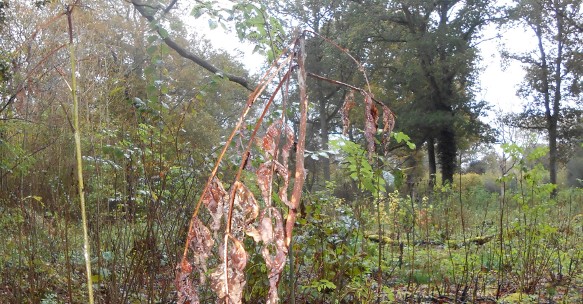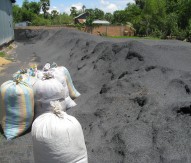
Ash dieback in the UK
The discovery of ash dieback in the UK in 2012 unleashed a remarkable chain of events. Forestry Commission staff carried out an extensive survey of known ash sites. Imported seedlings were checked in nurseries. The distribution of the disease rapidly expanded from original sites in East Anglia and Kent to Wales and northern Scotland, suggesting an alarming and improbable spread within a matter of months.
The scientific community sprang to life, featuring more tree health experts than seemed feasible after a long decline of agriculture and forestry at universities.
An arboreal apocalypse seemed imminent, fed by a steady flow of newspaper articles and television and radio programmes proclaiming, with varying degrees of accuracy, that the British countryside would soon be irrevocably changed. Ash became a tree of pivotal importance to the landscape, where once it was ubiquitous, but of no special importance.
Viewing the events of 2012 from the relative calm of winter 2013, when trees are dormant and disease spread has temporarily abated, several useful points can be made. Trees, including those with a relatively small commercial value, do matter to the wider public. Ash dieback has reinforced plans to beef up research in tree health and increase the number of scientists in this area. Tree health experts never quite disappeared, despite the despairing cries of a rump of scientists, but research capacity has been severely depleted.
The threat of ash dieback galvanised a number of groups to look at ways for involving the public, using ‘citizen science’ to monitor the spread of the disease. Despite ash dieback being only the latest in a series of ‘new’ tree pests and diseases to be recorded in the UK, it is unique in attracting so much attention.
This is positive news when set against some sobering facts. Ash dieback is here to stay. Many existing ash trees will become infected before replanting can begin to fill gaps. Even if few big trees die rapidly, based on evidence from mainland Europe, the dieback will seriously deplete tree foliage, kill branches and thin crowns. Younger trees will die. We don’t know how many, and even though intensive efforts are being made to model disease spread, there is still much to learn about how ash dieback will develop in the UK.
Bold Positive beginning
Research to examine potential resistance of ash to Chalara, the fungus responsible for the dieback, is a positive beginning. Yet resistance is a long-term solution, assuming it can be found and manipulated to permit replacement planting. There are, moreover, other problems not yet found in the UK which could cause serious damage to ash. Ash trees resistant to Chalara will still be a suitable food source for the highly destructive emerald ash borer, a devastating insect pest which occurs naturally in the Far East. Within 20 years of its discovery in North America it had killed up to 100 million ash trees. The insect has already spread into Europe (it is 250 km west of Moscow), and, in the absence of strict vigilance, could arrive in the UK within ten years.
Less well known is ash yellows, which occurs in North America but is most severe in Colombia, where planted urban ash has been systematically damaged in major cities. Ash yellows is a phytoplasma disease, a type of bacterium spread by insects. We do not, to the best of our knowledge, import any ash trees from Colombia, yet there is regular trade in plant materials that could introduce insect vectors carrying the disease. We need to assess such risks, as well as improve our overall knowledge of all pests and diseases on ash.
Useful parallels can be made between human and plant diseases. Modern science reveals much about pathogens in the isolation of a laboratory. Yet to date, molecular information has rarely told us anything useful about how to manage events in real life. We need simple tools for distinguishing ash dieback from other less damaging problems. False positive diagnoses will condemn trees to an unnecessary death.
Bold Important first step
The ban on importing ash tree seedlings from mainland Europe was an important first step in limiting spread of dieback in the UK. Selective cutting of ash trees may reduce spread, though in the absence of reliable information on aerial dispersal and longevity of fungal spores, it is difficult to specify the size of potential exclusion zones. There are other simple steps to take: raising awareness about the symptoms of the disease and ensuring people can distinguish them from potential lookalike problems; quick, accurate identification of the fungus from identified laboratories; and close monitoring of nurseries and destruction of infected material.
Looking beyond ash dieback and the myriad pest and disease problems attacking other trees in the UK, we need to be taking an active interest in assessing all potential threats. The response to ash dieback has been impressive at all levels – political, scientific, forestry industry – yet the fact is that the disease has been present in the UK for at least two, possibly three or more, years. Vigilance at borders and within the country needs to improve.
The UK has an impressive scientific community ready and willing to act. Foresters are already examining what they can do with existing knowledge. European scientists are collaborating with UK counterparts. There’s been a good start in bringing together what is known. Politicians, however, must make a long-term commitment to ensure that capacity in tree health is maintained and that we remain alert to new threats. Big trees do die, but this can be avoided. Prevention is conservation.
Eric Boa is an independent tree health specialist with widespread experience of training and advisory services.
Steve Woodward is reader in the Institute of Biological and Environmental Sciences, University of Aberdeen, co-ordinator of ISEFOR, a partner in BACCARA and a trustee of the Scottish Forestry Trust.

+44 1224 272669






